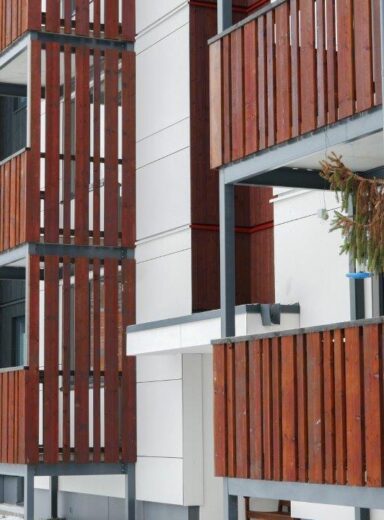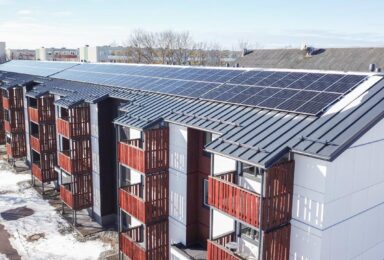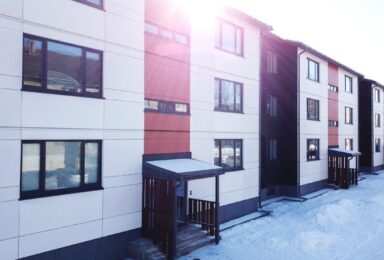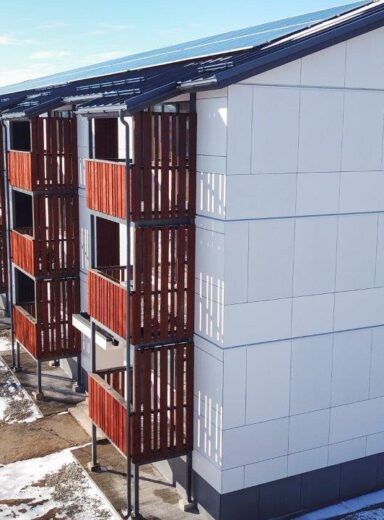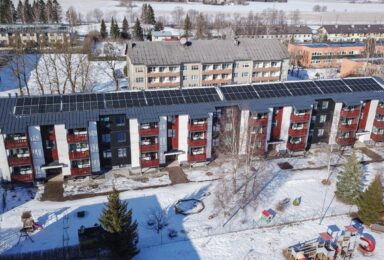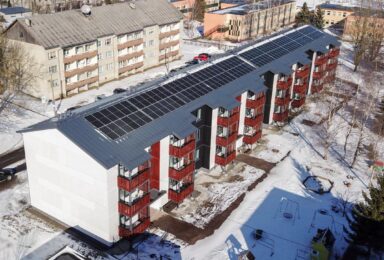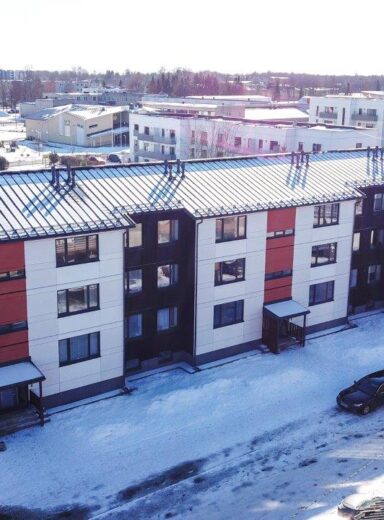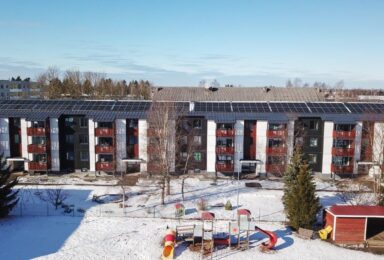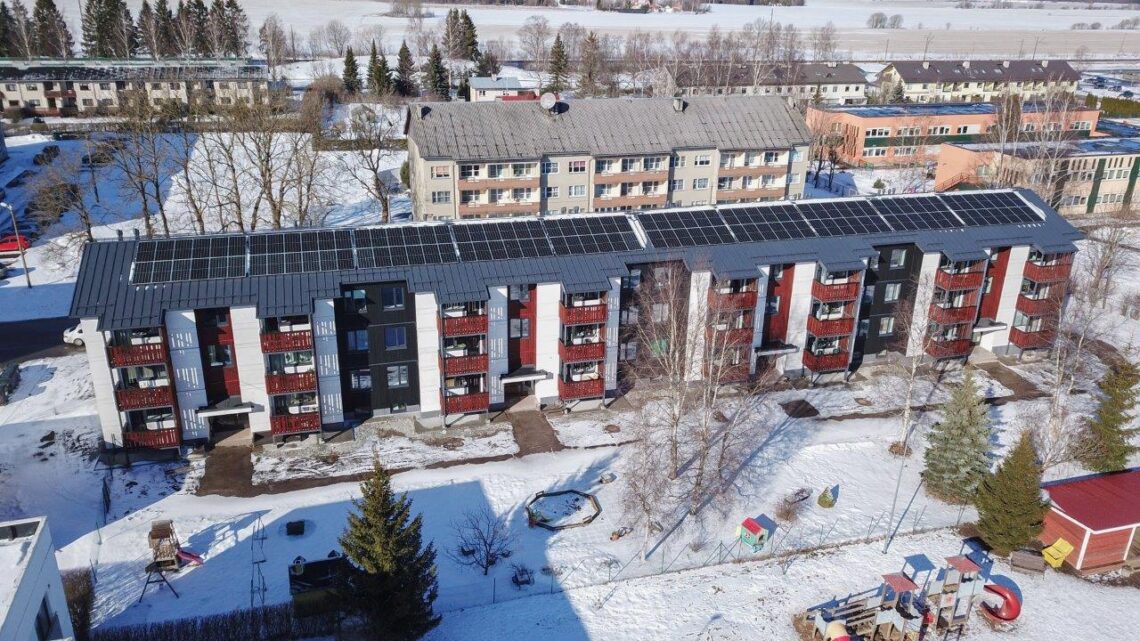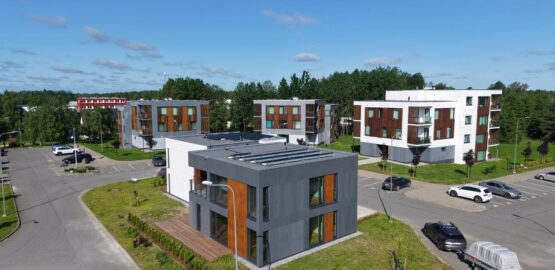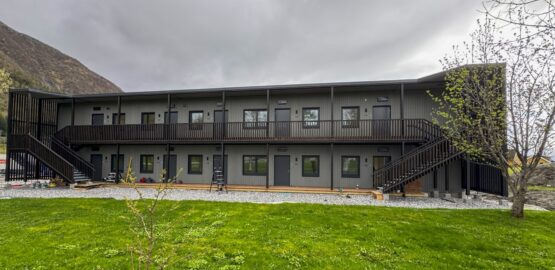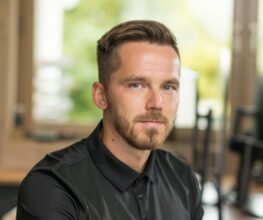Circular renovated apartment building in Saue, Estonia
In 2021, we renovated an apartment building in Saue, Harjumaa, based on the circular economy principle. The building has also been selected as a part of the Drive0 innovation project, and for us it is a unique opportunity to learn from a renovation project based on a circular economy.
The goal of the project was to reconstruct the apartment building in the most optimal way, doing it in a short period of time and to use building materials in such a way that they could be reused after the end of the life of the reconstructed building. During the project, products and materials of domestic origin are used as much as possible, for example facade elements and windows are produced in Estonia. In addition, we want to reuse the materials generated during the renovation as much as possible.
Before the start of the renovation work, the building was laser scanned. The result was a point cloud of the facade and surroundings of the apartment building, on the basis of which a digital 3D baseline model of the building was created in Autodesk Revit software.
Before starting the facade work, the building’s heating, water and sewage systems were also replaced, intake-exhaust ventilation with heat recovery was installed. The electrical system of the building was partially reconstructed.
In the renovation of the building, insulated facade elements produced in the factory were used. Before installing the elements, milling of larger window openings was also carried out in some rooms. Facade elements are covered with painted cement fiber board and combined wooden boards. In the production of the elements, ventilation strips were used, which were glued together from production scraps using the finger jointing method. The old windows were removed and replaced with triple-glazed plastic windows that were previously installed in wooden elements at the factory. An external wind barrier and an internal vapor barrier tape were used for the installation of the windows. The element structures are designed in such a way that they can later be removed from the walls and used for the same purpose on another building or disassembled.
Location: Kuuma 4, Saue, Estonia
Building size: 24 apartments in the apartment building
Energy class of the building: A
Construction method: a construction made of wooden elements, which was finished on site with facade tiles and wooden planks
Delivery: Timbeco delivered a turnkey solution
Project manager: Eero Nigumann
Energy efficiency
Before the renovation, the Saue apartment building was in the same condition as many other unrenovated apartment buildings built in the 80s. The biggest problems were large heat losses in the outer walls, a poorly functioning ventilation system and a heating system that did not allow apartment-specific regulation. Since the building’s energy label class was D, the goal was set to become a near-zero energy building, i.e. an A-class building. Thermal energy for space heating decreased by 76%. The use of primary energy for heat also decreased by 76% and total primary energy by 55%.
A year after the renovation, the Saue apartment building received an energy label based on energy use data, issued by Ehitusuuringud OÜ. The weighted energy use result of the apartment building is energy class A with a value of 92 kWh/(m2*a). According to KredEx, this result is one of the best that has been issued for reconstructed apartment buildings.
The energy label provides information about the actual energy consumption of the building. Energy consumption is considered to be the actual cost incurred for building heating, cooling, water heating, ventilation, lighting, use of electrical equipment, etc. The energy label given for the building’s actual energy consumption is valid for ten years. A total of 375 apartment buildings in Estonia have applied for an energy label since the end of the renovation process. Energy class A is assigned to 10% of apartment buildings.
Construction-demolition waste disposal-reuse
We utilized the construction demolition waste generated on the construction site in a way that allows as much as possible to recycle a lot of materials generated during construction:
• Bicycle racks were built for the residents of the house from the old pipes used in the heating system
• Concrete with recycled filler is used to pour the foundation of the building
• The roof sheet removed from the building was reused on the roof of a farm in southern Estonia
• Old windows are re-circulated and partially used in apartment owners’ cottages and in the construction of greenhouses
• Old cast iron radiators were partially reused in the corridors of the apartment building. Previously, the inside of the radiators was washed, the external surface was sandblasted and then painted over.
The complete reconstruction of Kuuma 4, Saue with prefabricated external wall elements in the factory was a challenging and very educational experience. During the nine months of work, we had to deal with both material supply difficulties and labor shortages due to the coronavirus, not to mention price increases. As a pilot project, it was a very successful project where a lot of data and lessons were collected so that future projects would be even more successful and smoother.
